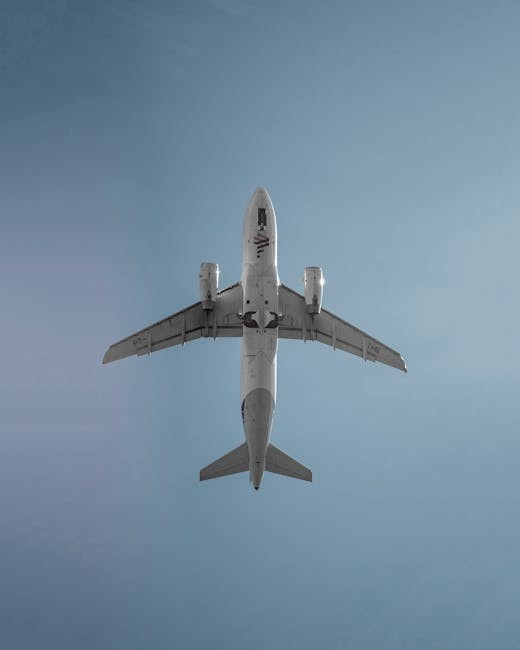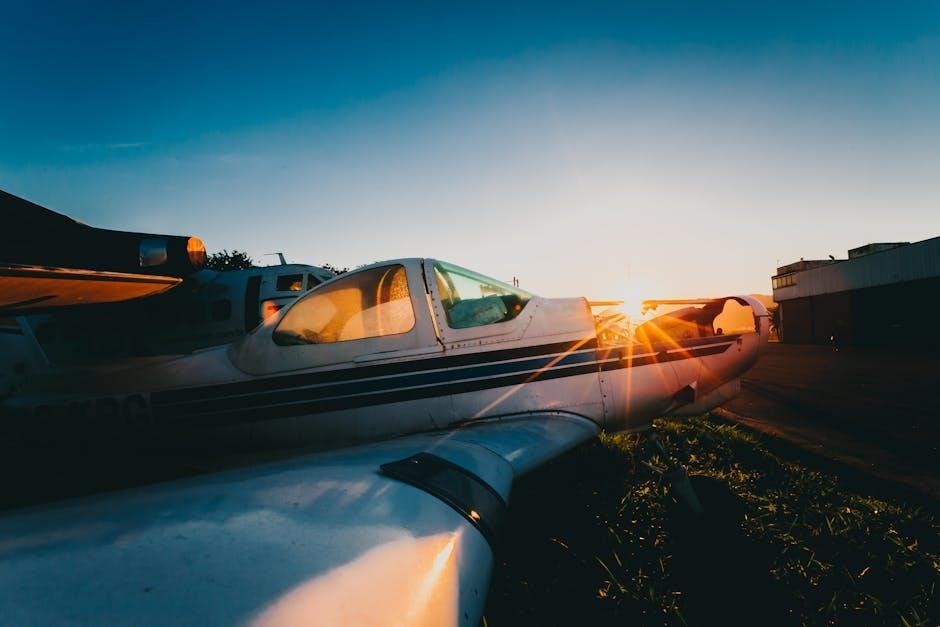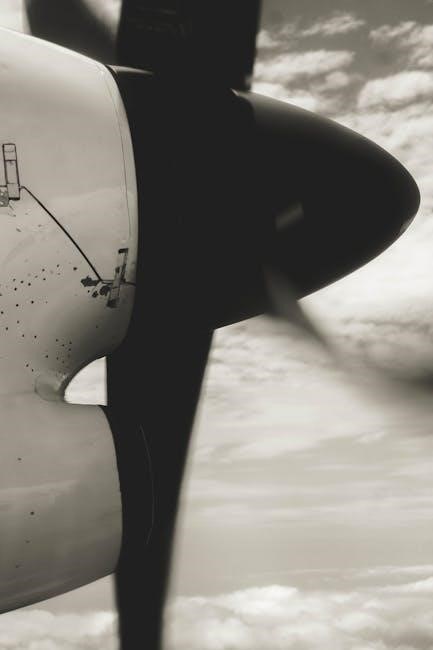Multi-engine flight testing is crucial for evaluating aircraft performance, safety, and handling characteristics․ It ensures pilots master complex maneuvers and emergency procedures, enhancing overall aviation safety standards․
Overview of Multi-Engine Aircraft
Multi-engine aircraft are designed with two or more engines, offering enhanced performance, redundancy, and safety․ Twin-engine planes, the most common type, feature two engines, propellers, and fuel systems․ These aircraft provide better climb rates, payload capacity, and the ability to continue flight if one engine fails․ They are widely used in professional aviation, training, and cargo transport․ Their design emphasizes balanced weight distribution and precise control, making them versatile for various flight operations․ Understanding their unique characteristics is essential for effective flight testing and training programs․
Importance of Flight Testing in Multi-Engine Training
Flight testing is essential for evaluating aircraft performance, handling, and safety under various conditions․ It ensures pilots develop critical skills in managing multi-engine operations, including emergency procedures like engine failures; Regular testing identifies potential issues, enhances safety, and verifies compliance with aviation standards․ By simulating real-world scenarios, flight testing prepares pilots for unexpected situations, improving their ability to respond effectively․ This process is vital for both initial certification and ongoing proficiency in multi-engine aircraft, ensuring reliable and efficient flight operations․

Multi-Engine Aircraft Fundamentals
Multi-engine aircraft offer enhanced performance, safety, and redundancy․ They require precise handling, with each engine contributing to thrust and control, ensuring balanced flight dynamics and efficiency․
Engine and Propeller Systems
Multi-engine aircraft rely on synchronized engine and propeller systems to ensure optimal performance․ Engines vary in type, such as piston or turbocharged, and are paired with propellers that can adjust pitch for efficiency․ Proper synchronization prevents vibration and maintains balanced thrust․ These systems are critical for takeoff, climb, and cruise phases, requiring precise monitoring and maintenance to avoid discrepancies․ Understanding their interplay is vital for safe and effective flight operations, ensuring maximum power output and fuel efficiency across all flight regimes․
Unique Characteristics of Twin-Engine Planes
Twin-engine aircraft offer enhanced performance and redundancy compared to single-engine planes․ Their design allows for continued flight on one engine, providing safety in emergencies․ The engines are typically synchronized to maintain balanced thrust and reduce vibration․ Unique features include the ability to handle asymmetric thrust conditions and individual throttle control for precise maneuvering․ These characteristics demand specialized training to master engine management and handling during various flight regimes, ensuring safe and efficient operation of the aircraft․

Pre-Flight Preparation
Thorough aircraft inspection, weight and balance calculations, and system checks are essential․ Proper fuel planning and emergency procedure reviews ensure safety and readiness for multi-engine flight testing․
Aircraft Inspection
A thorough pre-flight inspection is critical to ensure aircraft airworthiness․ Check propellers, control surfaces, and fuel systems for damage or leaks․ Verify all navigation and communication equipment functionality․ Inspect tires, brakes, and landing gear for wear or damage․ Ensure proper lubrication of moving parts and secure all access panels․ Review maintenance logs to confirm compliance with regulations․ A systematic approach ensures no critical issues are overlooked, enhancing safety during multi-engine flight testing․
Weight and Balance Calculations
Weight and balance calculations are essential for safe multi-engine flight operations․ These calculations ensure the aircraft’s center of gravity remains within allowable limits, considering fuel distribution, passenger loads, and cargo; Proper adherence to manufacturer guidelines and regulatory requirements is critical․ Accurate calculations prevent issues like reduced maneuverability or control loss, especially during asymmetric flight conditions․ Mismanagement can lead to compromised safety and performance, emphasizing the need for meticulous planning and adherence to established protocols․

Flight Test Procedures
Flight test procedures involve systematic evaluation of aircraft performance, including takeoff, landing, engine operation, and handling under various conditions to ensure safety and compliance with standards․
Takeoff and Landing Techniques
Mastering takeoff and landing in multi-engine aircraft requires precision and control․ Pilots must maintain proper airspeed, alignment, and configuration to ensure safe and efficient ground operations․ During takeoff, immediate action is needed if an engine fails, requiring skillful handling to prevent loss of control․ Landings demand careful approaches, with a focus on maintaining a stabilized glidepath․ Proper training and practice are essential to handle these critical phases effectively, adhering to established safety protocols and aircraft performance standards․
Engine Performance Tests
Engine performance tests are critical to assess the operational efficiency and reliability of multi-engine aircraft․ These tests evaluate thrust, power output, and fuel consumption under various conditions․ Pilots conduct propeller pitch control checks, monitor fuel flow, and analyze engine responsiveness․ Performance metrics are measured at different altitudes and power settings to ensure optimal functionality․ These tests also validate engine synchronization and identify any discrepancies in power delivery, ensuring safe and efficient aircraft operation during all flight phases․
Asymmetric Flight Training
Asymmetric flight training focuses on managing aircraft performance when one engine fails or differs in power output․ Pilots learn to recognize and respond to engine discrepancies, ensuring control during takeoff, climb, and cruise․ Training emphasizes smooth throttle adjustments, propeller pitch control, and maintaining directional stability․ By mastering these techniques, pilots can minimize performance losses and safely operate the aircraft under asymmetric conditions, enhancing overall flight safety and efficiency․
Emergency Procedures
Emergency procedures in multi-engine flight testing involve mastering engine failure management, system malfunctions, and recovery techniques to ensure safe operations under critical conditions․
Engine Failure Management
Engine failure management is critical in multi-engine aircraft․ Pilots must remain calm, reduce power on the functioning engine, and feather the failed propeller to minimize drag․ Immediate actions include declaring an emergency, securing the cabin, and configuring for single-engine operation․ Troubleshooting involves checking fuel flow, electrical systems, and hydraulic pressure․ If recovery isn’t possible, pilots must prepare for an emergency landing․ Post-failure procedures include completing checklists and notifying air traffic control․ Proper training ensures safe outcomes during such critical scenarios․
System Malfunction Handling
System malfunctions in multi-engine aircraft demand prompt, organized responses․ Pilots must quickly identify the issue, such as electrical or hydraulic failures, and follow checklist procedures․ Communication with air traffic control is essential to declare emergencies and request assistance․ Redundant systems should be activated to maintain control and stability․ If a system failure persists, pilots must prepare for alternative landing strategies․ Proper training and adherence to protocols ensure passenger and crew safety․ Regular practice of these scenarios is vital for effective malfunction management․
Post-Flight Procedures
Post-flight involves securing engines, completing checklists, and documenting issues․ Proper shutdown and systems verification ensure aircraft readiness for the next flight, maintaining safety and efficiency standards․
Debriefing and Analysis
Debriefing and analysis are critical steps after each flight test, ensuring lessons are learned and performance is improved․ Pilots and instructors review flight data, discussing successes, errors, and areas for refinement․ This process helps identify trends, reinforces proper techniques, and enhances safety․ Detailed analysis of engine performance, maneuver execution, and system functionality is conducted, with findings documented for future reference․ Effective debriefing fosters continuous improvement, preparing pilots for more challenging scenarios and ensuring compliance with safety standards․
Maintenance Checks
Post-flight maintenance checks are essential to ensure aircraft airworthiness and safety․ These inspections involve reviewing engine performance, propeller function, and system operations․ Technicians examine fuel levels, oil quality, and fluid leaks, while also checking for any wear or damage․ Logs are updated with findings, and any issues are addressed promptly․ Regular maintenance prevents potential failures, ensuring the aircraft remains operational and safe for future flights․ Compliance with these checks is vital for upholding aviation standards and protecting both the aircraft and its occupants․

Common Mistakes to Avoid
Overlooking inspection details and miscalculating weight and balance are frequent errors․ Inadequate asymmetric training and poor emergency procedure execution also pose risks, requiring vigilant attention and correction․
Inspection Oversights
Inspection oversights are critical mistakes that can compromise safety and performance․ Common issues include neglecting engine components, fuel system leaks, and control surface damage․ Pilots must ensure thorough pre-flight checks, paying attention to propeller condition, tire wear, and hydraulic systems․ Overlooking these areas can lead to in-flight malfunctions or emergencies․ Adhering to detailed checklists and maintaining vigilance during inspections are essential to prevent such errors․ Proper training and experience help reduce oversight risks, ensuring safer and more efficient flight operations․ Regular review of inspection procedures enhances consistency and accuracy․
Performance Calculation Errors
Performance calculation errors can significantly impact flight safety and efficiency․ Common mistakes include incorrect thrust settings, fuel consumption miscalculations, and inaccurate takeoff/landing distance estimates․ These errors often stem from improper data interpretation or mathematical oversights․ Pilots must ensure precise calculations, as they directly affect aircraft performance, especially during critical phases like takeoff and landing․ Regular training and the use of checklists can help mitigate these errors, ensuring accurate and reliable performance assessments․ Attention to detail is paramount to maintain operational safety and efficiency in multi-engine flight testing environments․
Training Tips
Effective practice strategies include regular flight simulations, focused drills, and systematic review of procedures․ Utilize checklists to ensure consistency and build muscle memory for complex maneuvers and emergencies․
Effective Practice Strategies
Effective practice involves structured sessions focusing on specific skills, such as engine failure simulations and asymmetric flight maneuvers․ Regular repetition of these drills builds proficiency․ Utilize flight simulators to rehearse complex scenarios safely․ Reviewing flight test guides and seeking instructor feedback enhances understanding․ Organizing practice around clear, achievable goals ensures steady progress․ Maintaining a detailed logbook to track improvements is essential․ Consistency and focused effort are key to mastering multi-engine aircraft operations․